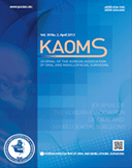Journal of the Korean Association of Oral and Maxillofacial Surgeons
- P-ISSN2234-7550
- E-ISSN2234-5930
- SCOPUS, KCI, ESCI
 ISSN : 2234-7550
ISSN : 2234-7550
CHARACTERISTICS OF FIBROUS DYSPLASIA DERIVED CELLS
Abstract
Purpose: Fibrous dysplasia (FD) is a fibro-osseous disease associated with activating missense mutations of the gene encoding the α-subunit of stimulatory G protein. FD may affect a single bone (called monostotic form) or multiple bones (called polyostotic form). The extent of lesions reflects the onset time of mutation. In this study, cells from monostotic FD in maxilla of a patient were isolated and cultured in vitro for characterization. Materials and Methods: The single cells were released from FD lesion which was surgical specimen from 15 years-old boy. These isolated cells were cultured in vitro and tested their proliferation activity with MTT assay. In osteogenic media, these cells underwent differentiation process comparing with its normal counterpart i.e. bone marrow stromal cells. The proliferated FD cells were detached and transplanted into the dordsal pocket of nude mouse and harvested in 6 weeks and 12 weeks. Results and Summary: FD cells have an increased proliferation rate and poor differentiation. As a result, cells isolated from FD lesion decreased differentiation into osteoblast and increased proliferation capacity. MTT assay presented that proliferation rate of FD cells were higher than control. However, the mineral induction capacity of FD was lesser than that of control. Monostotic FD cells make fewer amounts of bone ossicles and most of them are woven bone rather than lamellar bone in vivo transplantation. In transplanted FD cells, hematopoietic marrow were not seen in the marrow space and filled with the organized fibrous tissue. Therefore, they were recapitulated to the original histological features of FD lesion. Collectively, these results indicated that the FD cells were shown that the increased proliferation and decreased differentiation potential. These in vitro and in vivo system can be useful to test FD cell’s fate and possible
- keywords
- fibrous dysplasia, in vivo transplantation, proliferation, differentiation
- Downloaded
- Viewed
- 0KCI Citations
- 0WOS Citations